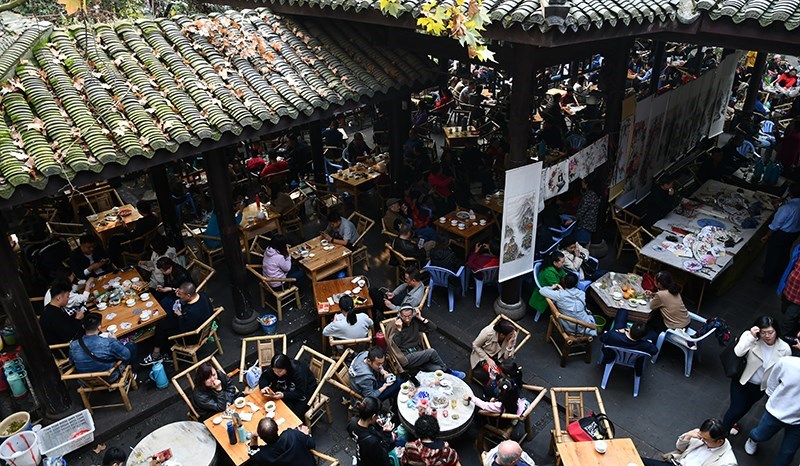Sichuan is located in the southwest of China, in the transition zone of the three climatic regions of the mid-subtropical areas, the northern subtropics, and the Qinghai-Tibet Plateau, and is not far from the warm temperate zone and the middle temperate zone to the north. Sichuan is an area where various geographical elements meet. From the Yulin River at an altitude of 150 meters in the east to the Gongga Mountain at an altitude of 7556 meters in the southwest, and spanning 8 latitudes from north to south and 11 longitudes from east to west, Sichuan is a large-scale, composite ecological transition zone in the center and west of China and includes all habitat types except the ocean.
With rich bird resources, Sichuan boasts more than 750 bird species, 41 species of which are Chinese endemic birds and rank first in China.
Birds in the Qinling region of Shaanxi are also particularly favored by the god. Qinling has a total of 435 species of birds and boasts very rich bird resources. Huayang Scenic Area is near to the Changqing National Nature Reserve in the north and contains biodiversity and natural landscapes of Qinling. With rich rare animals and plants, it is called "treasure of ecological resources of flora and fauna", and its biodiversity is known as a sanctuary for ancient relic plants and a paradise for wild animals in Qinling Mountains, especially known for the "Four Treasures of Qinling Mountains" living together: Crested Ibis (Nipponia nippon), Giant Pandas, Snub-Nosed Monkeys and Takin (Budorcas taxicolor).
We will start from Yangxian County, Shaanxi Province, and enter several great places for birding and some wildlife reserves: Qinling Nature Reserve, Tangjiahe Nature Reserve, Tiebu Sika Deer Nature Reserve, mountain and wetland bird area in Aba Autonomous Prefecture of Tibetan and Qiang Minority, mountain and canyon bird area in Ganzi Tibetan Autonomous Prefecture, Wolong Giant Panda Reserve, etc.
Yangxian County, the town of Crested Ibis (Nipponia nippon), boasts not only rare and protected birds - Crested Ibis (Nipponia nippon), but also the Changqing National Nature Reserve at Huayang in the north of Yangxian County. Huayang Scenic Area and Changqing Nature Reserve are located in the same mountain area where many national first class protected wild animals in China are living here: Giant Panda, Golden Snub-nosed Monkey, Takin (Budorcas taxicolor), Chinese Forest Musk Deer (Moschus berezovskii), and Golden Eagle (Aquila chrysaetos). Besides, there are 32 species of the second class priority protected wild animals, such as Himalayan Black Bear (Asiatic Black Bear, Ursus thibetanus), Himalayan Goral (Naemorhedus goral), Temminck’s Tragopan (Tragopan temminckii), Chinese Giant Salamander (Andrias davidianus).
In addition to the rare animal Takin in Tangjiahe, bird-watching enthusiasts took the Grey-crowned Crowtit (Paradoxornis przewalskii) for the first time, which makes Tangjiahe Nature Reserve quickly become one of the focus of bird-watching lovers. It is also a good place for watching Golden Pheasant (Chrysolophus pictus), Chinese Monal (Lophophorus lhuysii), Rufous-headed Robin (Luscinia ruficeps), Snowy-cheeked Laughingthrush (Ianthocincla sukatschewi, Garrulax sukatschewi).
The Tiebu Sika Deer Nature Reserve is home to the rare wild animal Sichuan Sika Deer (Cervus nippon sichuanicus, New Subspecific Sika Deer is also known as Sichuan Sika Deer). With a pleasant climate, rich vegetation, and a special geographical location, the Tiebu Sika Deer Nature Reserve provides an ideal "habitation" for wildlife habitat. In addition to Sichuan Sika Deer, there are 175 species of vertebrates such as Qinling lenok (Brachymystax lenok), Blue Eared-Pheasant (Crossoptilon auritum), Ocelot (Prionailurus bengalensis), Chinese Forest Musk Deer (Moschus berezovskii) and Himalayan Goral (Naemorhedus goral).
The wetland on Ruoergai Plateau is the most beautiful wetland in China, and is one of the major breeding place for Black-necked Crane (Grus nigricollis) and birds of anatidae on Qinghai-Tibet Plateau. Besides, it is the paradise for birds of prey that you can often watch, such as Himalayan Vulture (Gyps himalayensis), Cinereous Vulture (Aegypius monachus), Bearded Vulture (Lammergeier, Gypaetus barbatus), Common Kestrel (Falco tinnunculus), Saker Falcon (Falco cherrug), Grey Sea Eagle (White-talied Sea Eagle, Haliaeetus albicilla), Steppe Eagle (Aquila nipalensis), Golden Eagle (Aquila chrysaetos), etc. If we are lucky, we can watch Pallas’s Fish-eagle (Haliaeetus leucoryphus). Forest areas are also ideal places for observing birds, flocks of Blue Eared Pheasant (Crossoptilon auritum) and Blood Pheasant (Ithaginis cruentus) are appearing at the grassland of forest edge, and Common Pheasant (Phasianus colchicus) can be seen almost everywhere. Besides, many others are active in this area, such as Black-hcoled Jay (Sichuan Jay, Sichuan Grey Jay, Perisoreus internigrans), Snowy-cheeked Laughingthrush (Ianthocincla sukatschewi, Garrulax sukatschewi), White-browed Tit Warbler (Leptopoecile sophiae), Great Titi (Parus major), Common Rosefinch (Carpodacus erythrinus), wolf and fox.
Wolong - Balang Shan Mountain - Mengbi Shan Mountain is a concentrated and representative area of wild birds of the Qionglai Mountains. There are some very representative birds concentrated here, such as Chinese Monal (Lophophorus lhuysii), Temminck’s Tragopan (Tragopan temminckii), Golden Pheasant (Chrysolophus pictus), Tibetan Snowcock (Tetraogallus tibetanus), Szechenyi's Monal-Partridge (Tetraophasis szechenyii), etc. It is a good place to watch Firethroat (Calliope pectardens). However, you can watch raptor like Bearded Vulture (Lammergeier, Gypaetus barbatus) and many birds of Corvidate like Red-billed Chough (Pyrrhocorax pyrrhocorax), Yellow-billed Chough (Alpine Chough, Pyrrhocorax graculus). If we have luck, we can see the spectacular event of Grandala (Grandala coelicolor) gathering together. Wood Snipe haunts at the wet grassy slopes of the mountainside of Wolong.
On this trip, we pass through several nature reserves and have the opportunity to watch a large number of wild animals and birds. We’ll also enjoy the diverse natural scenery at different altitudes and unique ethnic customs in Tibetan areas.













